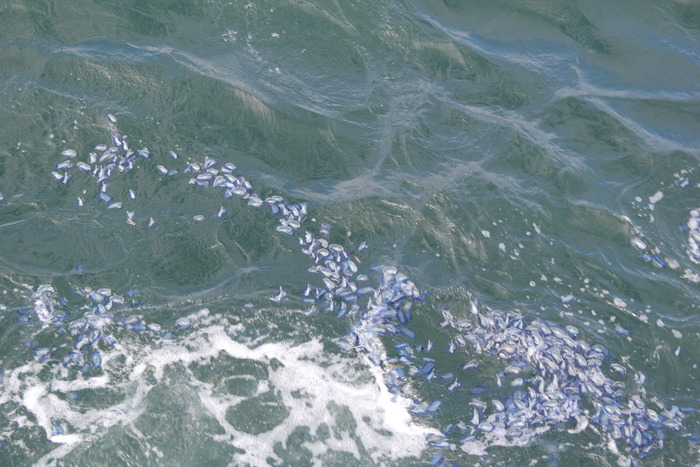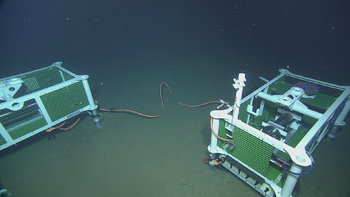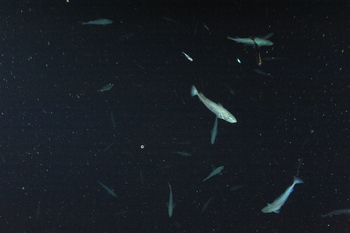Since arriving on the Slope Base Site (PN1A), we have observed hundreds of thousands of the small hydrozoan, Velella velella (aka By-the-Wind Sailors) floating at the surface near the ship. Velella are a hydroid colony, up to about 7 cm long. They are a deep blue color and have a small stiff sail, which propels them along the sea surface. Velella are predators on small plankton. The Bridge also reported that they observed a whale off in the distance, but sadly by the time we made it to the deck to look for it, it was gone. Lots of fish and other animals that live in the water column have been observed during the descent and ascent of ROPOS. We're not certain why so many fish were seen in this area at this time, but they are definitely feeding, and there is a great deal of marine snow (particulates of organic material) in the water. Images captured from ROPOS cameras will be used by the students to continue to create a photo catalogue of common benthic and pelagic animals at the shared RSN and EA cabled sites.
In non-biological news, the ROPOS engineers trouble-shot and completely fixed a set of connector issues that were causing the Port Manipulator arm to occasionally malfunction. While the repairs were going on, we conducted two important CTD Casts: 1) to characterize the environmental conditions in the core of the California Current in before deploying the similar types of sensors in this location on the Deep Profiler and adjacent seafloor packages and, (2) to allow the students to learn how to collect water samples for analysis. They learned how to fill the oxygen flasks quickly, but without causing too many bubbles or wasting too much water, and how to pickle the samples using chemical reagents to bind to the oxygen in the water.
After ROPOS was repaired, the ROV with ROCLS descended to the seafloor. They unspooled the cable, and surveyed the site. Then the previously deployed platform which served as an anchor for the cable lay, LV01A, was relocated to the far end of the just-laid cable, and the connector was plugged in to the LV01A node. The end of the cable closest to the Primary Node PN1A was fitted with a protective cap and stored nearby PN1A for later connection. Upon completion of all operations, the ROV and ROCLS ascended toward the ship by 1100. This dive represented the beginning stages of constructing the SubNet that will include the Deep Profiler and the HPIES (Horizontal Electrometer-Pressure-Inverted Echosounder) package at the Slope Base Site, to be deployed on later dives.
Another Dive (R1735) completed installation of a junction box with several instruments, including an ADCP, CTD, transmissometer, and a hydrophone, which were connected to the low-voltage node. While ROPOS was ascending back to the surface, the weather started turning, which would have made laying additional cable difficult. So the determination was made to head to Axial Seamount to continue deployments there. We should arrive there after dinner today, and the deployments will continue at the Axial Base Site PN3A.




